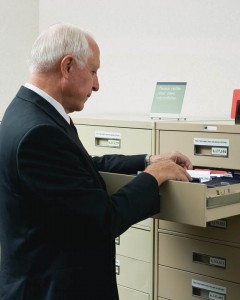One of the most frustrating things for me when doing Genealogy, is gathering information from others, asking them where they got the information and having them tell me, “I don’t know.”
 I sometimes feel like tearing out my hair, wondering why no one if what I’m reading is truth, simple speculation, exaggeration or complete fabrication. And what if I want to obtain a photocopy of the actual document? I can’t even know, without source material, where I might find that document.
I sometimes feel like tearing out my hair, wondering why no one if what I’m reading is truth, simple speculation, exaggeration or complete fabrication. And what if I want to obtain a photocopy of the actual document? I can’t even know, without source material, where I might find that document.
Good documentation is something the responsible genealogist will endeavor to accomplish. Whether you do Family History for yourself, your family or for others, part time or full time, documentation will save you and others to come a lot of frustration and time. I’ll tell you why.
Firstly, most of us are only able to do research in small increments. I know as a busy mother of three that’s how I work anyway. I’m not able to spend long hours researching. I do genealogy as time allows throughout the month, sometimes taking breaks for months at a time because I’m simply not able to get around to it until then. The first thing I do when I get back to whatever it was I was researching is to go through my research and correspondence logs so that I know where I left off. My research logs show me what sources (books, microfilm, etc.) I’ve already looked into, which keeps me from wasting time searching through things I’ve already searched. Believe me, it’s easy to forget where you’ve already looked for something in genealogy research as so many resources are available these days.
A research log is any method of keeping track of research. A correspondence log is any method of keeping track of persons with whom you’ve corresponded and what you’ve discussed. In genealogical research it’s a good idea to record the following:
Book or Microfilm/Microfiche Research
* The date on which the search was performed
* The location of the item searched including call number
* The Title and Author
* The Publication Information
* Specific Reference Information such as a page number, line number, etc.
* Information sought
* Information acquired
Letter or Phone Correspondence
* Date the letter was written or the call was made
* Name of the person queried
* Questions asked
* Information received
Internet Research
* Date the search was performed
* Name and URL (i.e. https://www.familysearch.org) of the web page
* Name of the author of the material on the web page
* Information sought
* Information acquired
Secondly, your documentation may help prevent others from doing duplicate research. Instead of being one of those who doesn’t know where their source material came from, you can offer it up to the benefit of future researchers. Your dedication to providing proof of information, will inspire confidence in your research capabilities which may prove an asset as you branch out and network with other distant relations or if you decide to move into the genealogy for hire field.
It’s not hard to start recording source material. There are many websites which offer printable Research Logs. You simply print out a copy, make additional photo copies for yourself and then take one with you whenever you do research.
Print out the FamilySearch Research Log
Print out the Ancestry Research Calendar
Print out the Ancestry Correspondence Record
Thirdly, remember that you can’t ever have enough documentation. The more, the better!
When my wife, Pam, began looking for documents to substantiate her birth date, she found plenty of them by searching through several drawers in our home, looking through some cupboards in her parents’ home, and visiting aunts and uncles. She located her birth certificate issued by the State Bureau of Vital Statistics, another issued by the hospital, and still another given by the doctor. Then she found a newspaper clipping announcing her arrival to the world. She also located an announcement her mother had sent to one of her aunts telling her about the great event. Her mother had written the happenings of that eventful day in a baby book. Her blessing certificate recorded her birth date and a visit to the ward clerk also confirmed it on her membership record. So she found eight sources very quickly proving that she was actually born on a certain date…
…You should go through this same process to verify each date and place on your family group record for each individual member of your immediate family. Some of the information will be quick and easy to find. Some will be more difficult, but can be found with a little perseverance. – George D. Durrant and Noel R. Barton, “To Go Forward, Go Back: How to Complete the Four-generation Program,” Ensign, Feb 1978

